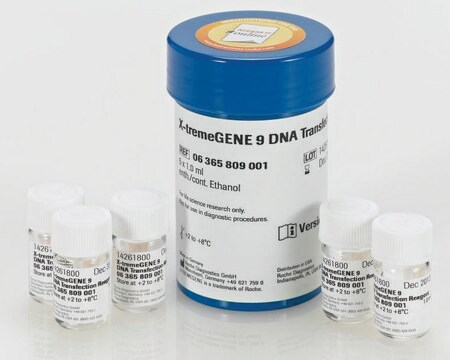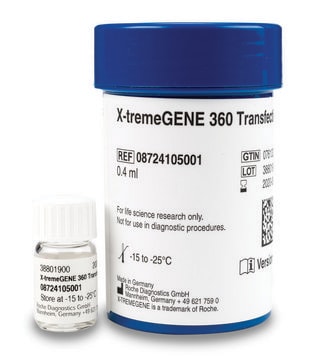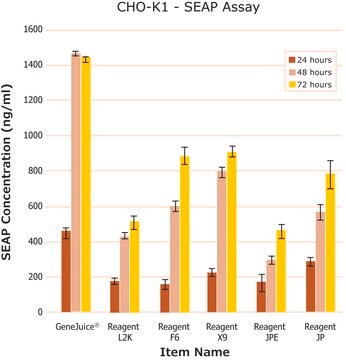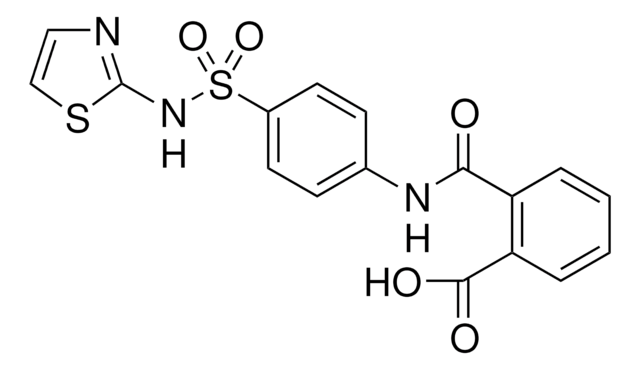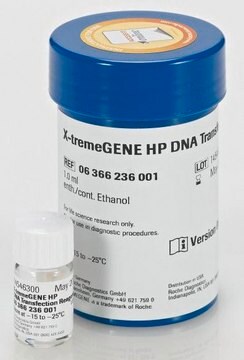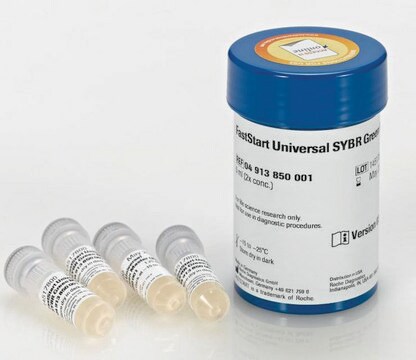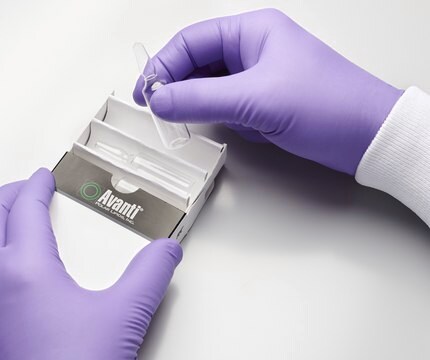추천 제품
Grade
for molecular biology
Quality Level
형태
liquid (aqueous solution)
사용
mL (suitable for 165 transfections)
포장
pkg of 0.4 mL (06366244001)
pkg of 1.0 mL (06366236001)
pkg of 5 × 1 mL (06366546001)
제조업체/상표
Roche
기술
transfection: suitable
저장 온도
−20°C
1 of 4
이 품목 | XTG9-RO | XTG360-RO | SITRAN-RO |
|---|---|---|---|
| grade for molecular biology | grade for molecular biology | grade for molecular biology | grade for molecular biology |
| manufacturer/tradename Roche | manufacturer/tradename Roche | manufacturer/tradename Roche | manufacturer/tradename Roche |
| form liquid (aqueous solution) | form liquid (aqueous solution) | form liquid (aqueous solution) | form - |
| packaging pkg of 0.4 mL (06366244001), pkg of 5 × 1 mL (06366546001), pkg of 1.0 mL (06366236001) | packaging pkg of 0.4 mL (06365779001), pkg of 1.0 mL (06365787001), pkg of 5 × 1.0 mL (06365809001) | packaging pkg of 0.4 mL (08724105001), pkg of 1.0 mL (08724121001), pkg of 5 × 1.0 mL (08724156001) | packaging pkg of 1 mL (04476093001 [1 mg/ml]), pkg of 5 × 1 mL (04476115001 [5 x 1 mg/ml]) |
| Quality Level 100 | Quality Level 100 | Quality Level - | Quality Level 100 |
일반 설명
특징 및 장점
- Benefit from an easy-to-use non-liposomal reagent that is free of animal-derived components, stable at room temperature, filtered through 0.2 μm pore size membrane, and active in serum-containing medium.
- Achieve new levels of transfection efficiency in primary cells and tumor cell lines that are not transfected well by other reagents.
- Generate physiologically relevant data using a reagent with low cytotoxic effects.
- Increase experimental throughput and enable target evaluation using a simple and consistent protocol.
품질
물리적 형태
기타 정보
법적 정보
관련 제품
신호어
Danger
유해 및 위험 성명서
Hazard Classifications
Eye Irrit. 2 - Flam. Liq. 2
Storage Class Code
3 - Flammable liquids
WGK
WGK 1
Flash Point (°F)
334.4 °F
Flash Point (°C)
168 °C
시험 성적서(COA)
제품의 로트/배치 번호를 입력하여 시험 성적서(COA)을 검색하십시오. 로트 및 배치 번호는 제품 라벨에 있는 ‘로트’ 또는 ‘배치’라는 용어 뒤에서 찾을 수 있습니다.
샘플 COA가 필요하신가요?
이는 샘플 분석 증명서(COA)이며 이 특정 제품의 최근 제조된 로트를 대표하지 않습니다.
이미 열람한 고객
문서
Automation is used for many applications to reduce variation caused by manual handling and to obtain reproducible results in high-throughput assays. High-throughput applications, such as knockdown studies or target screenings, often include cell transfection.
Small inhibitory RNAs (siRNAs) have become the focus of interest in many laboratories. For the first time, these molecules offer an easy way to knock down the expression of selected genes in mammalian cells without having to resort to classical gene knockout techniques.
Transfection is the introduction of DNA, RNA, or proteins into eukaryotic cells and is used in research to study and modulate gene expression. Thus, transfection techniques and protocols serve as an analytical tool that facilitates the characterization of genetic functions, protein synthesis, cell growth and development.
This brief webinar provides an overview of what transfection is and the methods that are used to introduce DNA or RNA into eukaryotic cells.
프로토콜
Lentiviruses represent a powerful tool in research applications to transduce a wide range of cell types.
관련 콘텐츠
Browse our convenient transfection reagent selection guide to match the best reagent for your specific cell line and application needs.
자사의 과학자팀은 생명 과학, 재료 과학, 화학 합성, 크로마토그래피, 분석 및 기타 많은 영역을 포함한 모든 과학 분야에 경험이 있습니다..
고객지원팀으로 연락바랍니다.
